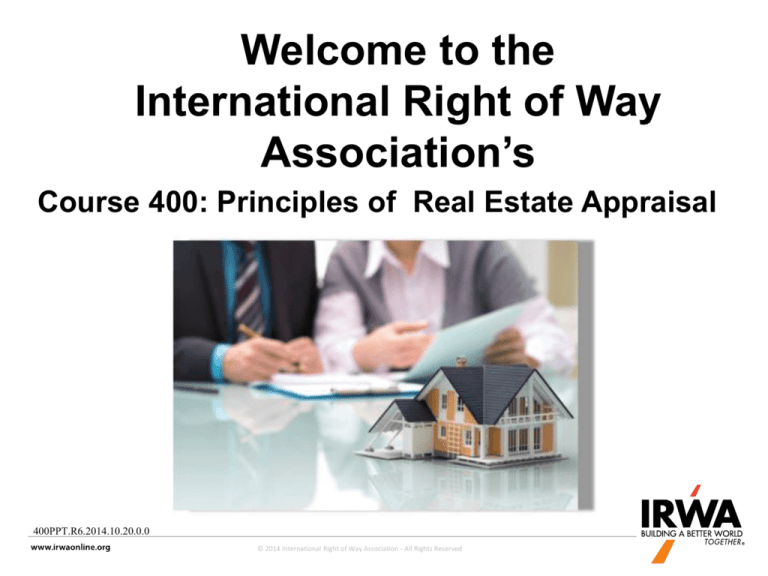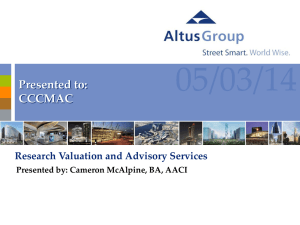
Welcome to the
International Right of Way
Association’s
Course 400: Principles of Real Estate Appraisal
400PPT.R6.2014.10.20.0.0
© 2014 International Right of Way Association - All Rights Reserved
Introductions
Who we are…
What we do…
Where we do it…
How long we’ve been doing it…
Our goals for the course...
2
Objectives
At the conclusion of course, you will be able to...
Express an understanding of basic real estate terms and principles
Demonstrate a basic knowledge of the valuation process and its
components
Discuss the definitions of and steps in each of the three (cost, sales
comparison, and income capitalization) approaches to value
Solve problems that show an understanding of the three approaches
to value
© 2014 International Right of Way Association - All Rights Reserved
3
Housekeeping
© 2014 International Right of Way Association - All Rights Reserved
4
Schedule
The schedule will proceed as follows:
Day One
8:00 - 8:15
Introductions, etc.
8:15 - 9:45
Characteristics of Real Estate and Real Property.
Definitions. Documents.
9:45 - 10:15 Cost, Price, and Value
10:30 - 11:00 Factors That Create and Affect Value
11:00 -12:00 Value Principals
1:00 - 5:00
Valuation Process
8:00 - 8:15
8:15 - 2:30
2:45 - 3:15
3:15 - 4:00
4:00 - 5:00
Day Two
Recap Day One and Introduce Day Two
Three Approaches to Value
Partial Acquisitions
Summary and Review
Examination
5
Real Estate and
Real Property
Real estate is the physical land and
appurtenances to the land.
Real property is all the rights, interests, and
benefits inherent in the ownership of the real
estate. It is the bundle of rights.
© 2014 International Right of Way Association - All Rights Reserved
6
Personal Property, Fixtures, and
Trade Fixtures
Personal Property is the items
that are not affixed to the real
estate.
Fixtures are items that were once
personal property but have since
been permanently attached to the
real estate.
Tests:
Manner affixed
Adaptation
Intent
Trade fixtures are not part of the
real estate
© 2014 International Right of Way Association - All Rights Reserved
7
Appraisal
An appraisal is:
The act or process of developing
an opinion of value
A written statement
Setting forth an opinion of value.
Supported by the presentation
Analysis of relevant market
information
8
Controlling Documents
Uniform Standards of Professional Appraisal
Practice. (USPAP)
“The Yellow Book“
The Uniform Act
9
Cost, Price, Value
Cost is the amount spent to construct
improvement.
Price is the amount paid for a good or
service.
Value is the worth of a good or service.
10
Market Value
• Market value is a type of value, stated
as an opinion, that presumes the
transfer of a property…as of a certain
date, under specific
conditions…relationship, knowledge,
and motivation; terms of sale; conditions
of sale.
11
D.U.S.T. (Factors That Create Value)
Demand:
• The desire or need for real estate
Utility:
• Usefulness
Scarcity:
• The supply of real estate in relation to demand
Transferability:
• Title must be able to pass
12
E.E.G.S. (Factors That Affect Value)
Economic:
• The relationship among demand, supply, and utility
Environmental:
• The natural and developed environment
Governmental:
• Related to the government
Social:
• Related to demographics
13
Value Principles (Principle of
Substitution)
• When several similar goods or services
are available, the one with the lowest
price will attract the greatest demand.
14
Value Principles (Highest and Best Use)
• The reasonably probable and legal use
that is physically possible, appropriately
supported, and financially feasible and
that results in the highest value.
15
Value Principles (Principle of Supply
and Demand)
• The price of
a good or
service
varies
directly with
demand and
inversely with
supply.
16
Value Principles
(Principle of Anticipation)
• Present value
is created by
the
expectation of
future
benefits.
17
Other Principles
• Change
• Consistent Use
• Contribution
18
Valuation Process
Appraisal Problem Definition
Scope of Work
Data Collection and Analysis
Land Value Opinion
Three Approaches to Value
19
Valuation Process
Appraisal Problem Definition
Identification of the client, intended use, and users
Value to be developed
Date of the value opinion
Identity and location of the subject property
Property rights to be valued
Limiting conditions
20
Valuation Process
Scope of Work
Degree to which the property is inspected or identified
Extent of research into physical and economic factors
Extent of data research
Type and extent of analysis applied to arrive at opinions or conclusions
21
Valuation Process
Data
Collection and
Selection
Subject
property data
Market area
data
Comparable
property data
22
Valuation Process
Data Analysis
Market analysis
Highest and best use
analysis
23
Valuation Process
Highest and Best Use
The reasonably probable and legal use that is physically possible,
appropriately supported, and financially feasible and that results in the
highest value.
Physically
possible?
Legally
permissible?
Financially
feasible?
Maximally
productive?
24
Valuation Process
Land Value Opinion
Allocation
Extraction
Ground rent capitalization
Land development
25
Day One Recap
Today, we...
Defined some terminology.
Discussed some controlling documents.
Examined the factors that create value and the factors that affect
value.
Reviewed and discussed value principles as they relate to real
estate valuation.
Started to examine the valuation process, specifically appraisal
problem definition, scope of work, data collection and selection,
and data analysis.
26
Day Two
Today, we will…
Complete the analysis of the valuation process.
Specifically the three approaches to value (cost, sales comparison,
and income capitalization), the reconciliation of the value opinions into
a final value opinion, and the report of the defined value.
Look briefly at partial acquisitions.
Complete the Case Studies and take the exam.
27
Valuation Process
Three Approaches to Value
Cost Approach
Sales
Comparison
Income
Capitalization
28
Valuation Process
Add land
value opinion
to the
depreciated
improvement
value
Cost
Approach
Develop a
value opinion
for the land
Deduct
depreciation
Estimate the
cost new of
the
improvement
29
Valuation Process
Cost Approach
Depreciation: Age-Life Method
Depreciation Percentage =
Effective Age
Total Economic Life
30
Valuation Process
Reconcile the
value
indications
into
a final value
opinion
Sales
Comparison
Approach
Compare the
sales to the
subject and
adjust for
dissimilarities
Research the
market for
comparable
data
Develop
relevant units
of comparison
31
Valuation Process
Income Capitalization Approach
The conversion of income into value through a
rate or a ratio.
Gross Rent Multipliers
Direct Capitalization
32
Valuation Process
Income Capitalization Approach
Gross Rent Multipliers
Gross Rent Multiplier = Sale Price
Gross Rent
33
Valuation Process
Income Capitalization Approach
Estimate the subject’s annual potential gross income
Determine a vacancy and collection loss
Subtract the vacancy and collection loss from the potential gross income
Estimate annual property expenses and subtract the expenses from the effective gross income to arrive
at the net operating income
Develop a capitalization rate
Convert the net operating income into value
34
Valuation Process
Income Capitalization Approach
Direct Capitalization
Value = Net Operating Income
Capitalization Rate
or Vo = NOI
Ro
35
Valuation Process
Reconciliation and
Final Value Opinion
36
Valuation Process
Defined Value Opinion Report
Appraisal Report
Restricted
Appraisal Report
37
Partial Acquisitions(1)
Larger parcel is the total
property
before the taking.
• Contiguity
• Title
• Use
Value of the part taken is
determined
by multiplying the quantity
taken
times the before unit value
of the item.
Benefits to the remainder
property represent
the increase in value to the
remainder
property as a result of a
partial acquisition.
Damages to the remainder
property
represent the loss in value to
the
remainder property as a
result
of a partial acquisition.
38
Partial Acquisitions(2)
Federal (Before and After) Rule is the
difference between the value before the
acquisition and the value after the acquisition.
State (Summation) Rule is the value of the part
taken plus (damages to the remainder property
minus benefits to the remainder property
[the damages minus the benefits cannot
be less than zero dollars]).
39
Objectives
Now you should be able to...
Express an understanding of basic real estate terms
and principles
Demonstrate a basic knowledge of the valuation
process and its components
Discuss the definitions of and steps in each of the
three (cost, sales comparison, and income
capitalization) approaches to value
Solve problems that show an understanding of the
three approaches to value
© 2014 International Right of Way Association - All Rights Reserved
40
Thank you!
41








